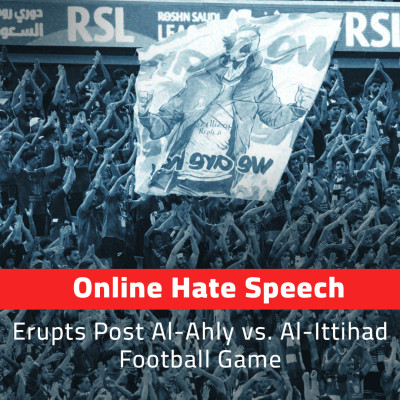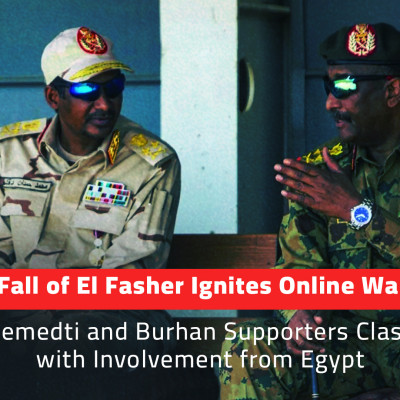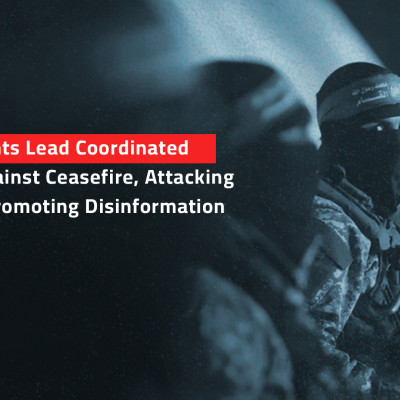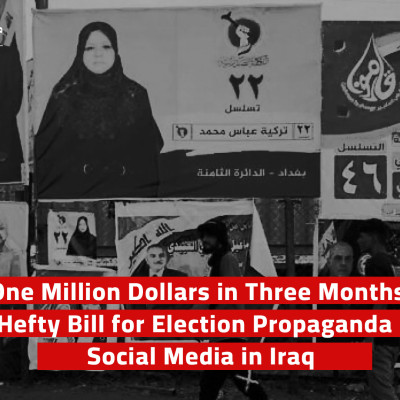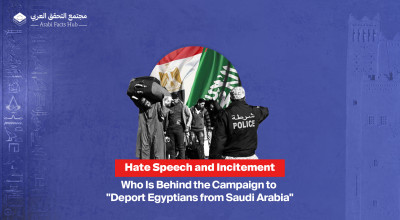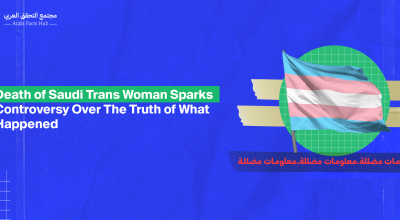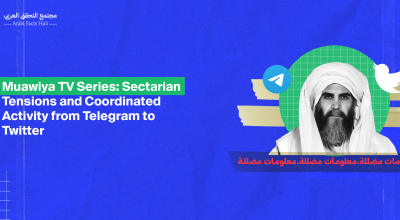The Nairobi Declaration: The Story Behind Abdalla Hamdok's Propaganda Campaign

In May, former Sudanese Prime Minister and head of the Leadership Council of the Civil Democratic Forces Coordination (Taqaddam), Abdalla Hamdok, signed a declaration with the leaders of two armed movements in Kenya. The goal of this "Nairobi Declaration" is to end the war, establish a secular state, and affirm the right to self-determination.
_____________________________________________________________________________________
Abdalla Hamdok became the first Prime Minister of Sudan on 20 August 2019 after the ouster of Omar Al Bashir in April of the same year. He was chosen after deliberation between the civil forces that participated in the revolt against the former president and military council. Hamdok remained in his position until the military coup which took place in October 2021. He resumed his office a month later and then resigned three months after returning.
Six months after the war broke out between the Sudanese military led by Abdel Fattah Al Burhan and the Rapid Support Forces (RSF) led by Mohamed Hamdan Dagalo ("Hemedti"), Hamdok returned to the political arena through the Coordination of Civil Democratic Forces - Taqaddum.
Hamdok faced accusations of supporting the RSF politically and of being backed by Gulf countries. An accusation which he denies, emphasizing that "Taqaddam does not side with any party in the conflict." Amid the controversy and mixed reactions regarding the "Nairobi Declaration" signed between Hamdok, Abdelaziz Al Hilu (leader of the Sudan People's Liberation Movement-North - SPLM-N), and Abdelwahid Al Nur (leader of the Sudan Liberation Movement), a propaganda campaign for the former prime minister emerged on X. Dozens of accounts displayed coordinated, inauthentic activity aimed at praising Hamdok and regularly spreading his statements. These accounts also defended the interests of the UAE, criticized the Sudanese army supported by Iran, and expressed support for the Rapid Support Forces. Media reports indicate that the UAE supports the Rapid Support Forces over the Sudanese army, despite official denials.
The posts appeared under several hashtags, including: #EvilIran, #IranAndTheKizanAreOne, #TheKizanAreTheCauseOfTheWar, #TheKizanToTheDustbinOfHistory, #RapidSupportForcesGuardiansOfTheNation, #BurhanIsAnAgent, #BurhanIsATraitor.
From February to June 5, over 53,000 posts were published using these hashtags, according to statistics from Meltwater, a tool specializing in social media analysis.
Activity of Hashtags Related to the War in Sudan – Meltwater
Campaign Accounts
According to our analysis, most accounts associated with the campaign were created in 2023. The activity of these accounts resembles that of fake accounts, but we identified several indicators suggesting they are more likely semi-automated accounts. This means they are managed collectively by real people to achieve specific goals, or they might be operated by an organization.
Some accounts describe themselves as "social influencers," yet have only a few hundred followers. Many use profile pictures featuring Dubai destinations, and some indicate that their owners are based in the UAE, while others show activity from Sudan. Additionally, some profile pictures are not genuine.
For example, the account @hms12001, created in January 2023, just a few months before the Sudan war, uses a profile picture of an Ethiopian girl taken in Dubai Marina.
In the beginning posts by the “Hams” account tackled public and non-political issues, then it moved to posting directed political content in favor of Hamdok and the RSF. This content was copied on “Hams” accounts on different social media platforms, which is contrary to normal human behavior. A real person posts differently depending on the social media platform. For instance, Facebook and Instagram users post more personal content, whereas X is a more serious platform and that is reflected in what is posted there.
This pattern is repeated by other accounts such as Zahya El Hily on Facebook (Account ID = 100090306978895), on Instagram (@zahya_el_hily), and X (@zahiaelhily2). El Hily presents herself as “a Sudanese living abroad. I love travel, coffee, and shopping.” Zahya posts political content that is identical on all three platforms.
Campaign accounts typically refer to other accounts in its posts. Some of these referenced accounts seem to be owned by real people, and some support the RSF as their handles suggest. For example, “Rapid Electronic Deterrence”, “Rapid Support Kings”, as well as “Supportee” and “Supportess”. Some of these accounts feature pictures of Hemedti as their profile pictures as well as the logo “Rapid Support”, and quotes from the armed group, like “readiness, swiftness, and resolution.” These accounts also mention other accounts seeking support in the promotion of posts given the wide following that the mentioned accounts enjoy. All of these accounts are politically aligned, they all publish content in promotion of the Rapid Support Forces which also indicates they are part of the propaganda machine for the RSF.
Posts by some of these accounts tried to justify the RSf’s targeting of civilians with the claim that the civilians were involved in murders against the RSF, which takes them out of the scope of the Geneva Convention on the Protection of Civilians in Armed Conflict.
Accounts with a large following make a point to mention accounts with fewer followers to attract more attention to them.
Some high-following accounts: @betgened1, @wdalbehair, @HD_894, @bwlynd4, @aDams_RFS, @RapidSupportSdn, @ashawes5, @alaaty88, @noureldeen_1997, @MShareefi, @Herculesami, @ISSA8MUSA, @t8feeel.
Praise for Hamdok and Criticism of Burhan and the Sudanese Army
Campaign accounts praised Hamdok, calling him the "founder," and frequently shared excerpts of his statements. Meanwhile, some posts labeled Burhan as a "traitor and agent" and described the Sudanese army as "remnants and extremists." These accounts made sure to post in both Arabic and English.
Examples of these coordinated posts:
"History will never forget the contributions and sacrifices of Abdalla Hamdok in Sudan's journey towards freedom and justice. His name will be etched in gold in the hearts of Sudanese people and the world.""Hamdok calls for the deployment of military observers to Sudan... the perfect model of democracy and civility that we aspire to. "Burhan's regime fears the strength and popularity of Abdalla Hamdok, so they have tried desperately to tarnish his reputation and fabricate charges against him, but they have failed and will always fail.
Campaign accounts used similar backgrounds and designs containing praises for Hamdok and Hemedti.
Attacks on Iran and the Muslim Brotherhood
At the end of 2023, Sudan and Iran resumed their military cooperation following the re-establishment of diplomatic relations after a seven-year freeze, which began after the Saudi embassy was stormed in 2016. In recent months, Iranian-made drones, such as the Mohajer-6, were observed in Sudan’s skies and used by the army in battles against the Rapid Support Forces. Despite the relative calm in diplomatic relations between Iran and Gulf countries, fierce debates erupted on social media between supporters of both sides, each trying to impose their narrative on these platforms.
Some of the accounts involved in the Hamdok campaign also participated in campaigns criticizing Iran's role in Sudan. One notable campaign was launched shortly after Sudanese Foreign Minister Ali Al Sadiq visited Tehran in February 2024. At that time, campaign accounts posted high-quality, attractively designed images featuring Burhan, former Iranian President Ebrahim Raisi, and Quds Force Commander Esmail Qaani, with captions like:
- "Iran aids Sudan with ambitions of extending Shia influence.. Iran covets a fifth capital.. Iran assists the Sudanese army for its own interests.. Iran collaborates with Burhan to destroy regional nations and maritime navigation."
In March 2024, The Wall Street Journal reported that a Sudanese intelligence official stated, "Iran requested to build a permanent naval base on the Red Sea coast, but Khartoum refused."
While these accounts did not post identical content, their posts shared similar themes, images, and designs. Phrases like "Iranian Shia expansion in Sudan" and "alignment with Iran" repeatedly appeared in the posts supporting Hamdok's campaign.
Examples of tweets:
- "Iranian Shia expansion in Sudan threatens regional stability and could lead to an international crisis with dire consequences. #RegionalStability #Sudan #Iran #TheKizanToTheDustbinOfHistory."
- "The Kizan's alignment with Iran raises international concerns over escalating tensions and conflicts in the region, necessitating wisdom and diplomatic dialogue to prevent further bloodshed and unrest. #Sudan #Burhan #Iran."
- "While the world strives to limit #Iran's influence and undermine its regional impact, #Burhan chooses to side with them, potentially harming Sudan’s relations with influential countries and negatively affecting the country’s economy and security. #Evil_Iran."
Some accounts suggested an alleged collaboration between the Sudanese army and the Muslim Brotherhood, known in Sudan as the "Islamic Movement." The UAE maintains animosity towards all Muslim Brotherhood-affiliated groups in different countries.
Showing Support for the UAE
In addition to praising Hamdok and criticizing Burhan and Iran, accounts participating in the campaign consistently posted content lauding the UAE's role in Sudan and the region. For example, accounts like @amina98 and @aalsharif00 shared posts about alleged aid provided by the UAE to Sudan since the onset of the war.
Not only did this network of accounts amplify the UAE's role; they also attacked UAE critics on X. For instance, when a Sudanese army supporter, @walaaelsadig, criticized what he called the UAE’s "meddling", @aminaa98 replied, "Firstly, Hemedti stands with the people's choice. Who supports the Kizan? Finally, England ... admit your failure, you wretched Kizan."
Another UAE-supporting account, @hms12001, responded to @Bit_Khalifa1417's criticism of the UAE's role in Sudan by stating, "Your problem, Kizan, is that you're stuck in the past with outdated ideas. Influential countries like the UAE intervene to protect their interests and, at the same time, the interests of the Sudanese people. Is intervention only bad now? When the UAE was sending aid and creating job opportunities for the Sudanese before the war, they weren't demons then!!"
Similarities and Possible Links with Yemeni Campaigns
The high quality of the designs and images used in the promotional campaign for Hamdok and the Rapid Support Forces suggests the involvement of a professional production team. The production style of campaign materials resembles another influence campaign identified by Arabi Facts Hub, which targeted the leader of the Al Mahra sit-in, Ali Salem Al Huraizi. Similar to Hamdok's campaign, the smear campaign against Al Huraizi featured posts in English and high-quality designs.
The overlap doesn't end there. Some accounts from Hamdok's campaign also participated in the campaign against Al Huraizi. For example, the account @BatoulELkhier reposted content from the Yemeni network “Ejaz” @ejaznetwork, which was also involved in the smear campaign against Al Huraizi. Our investigation into the Al Huraizi campaign previously revealed that the “Ejaz” network is operated by five accounts based in Egypt, one in the UAE, and one in Yemen.
The latest posts from the “Batoul ELkhier” account focus on the situation in Sudan, but its initial posts from 2013, written in Lebanese dialect, addressed issues in Lebanon. This suggests that the account was not originally Sudanese but later shifted to commenting on Sudanese issues. Supporting this theory is the fact that the account has only 472 posts, a low number for an account created in May 2013, indicating that a large number of posts might have been deleted to repurpose the account for a new campaign or goal. This is common practice in initiating coordinated online campaigns.

















